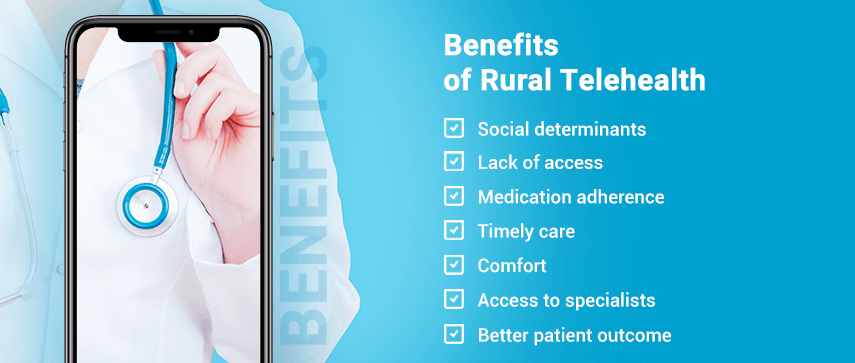Telemedicine is gradually making its place in the global market. However, it is of utter importance to spread technology in rural areas, where there is a shortage of healthcare services. With its growing stage, there are plenty of challenges in telemedicine to overcome. But the advantages are significant enough to implement and adopt by the rural areas across the world, with improved broadband and telecommunication facilities.
Telemedicine aims to help healthcare centers, hospitals, and other healthcare providers to provide better access and improved medical facilities. It enables in assisting and delivering healthcare services. The technology enhances the communications between the doctor and the patient, with better patient monitoring, and easy healthcare accessibility. It uses electronic medium and telecommunication technology for the exchange of data to provide clinical assistance to the patients. In comparison with the urban areas, the rural areas need telemedicine services even more urgently. This is so as:
- Rural areas have a higher percentage of unhealthy behaviors.
- They have lesser and more difficult access to healthcare
- Weak transportation system that results in delayed healthcare treatment
- Poor access to healthy food
- Lack of hygiene
Challenges Related To Telemedicine Services In Rural Areas
Though technology would witness a bright future, it has some key challenges, which need a solution. Let us discuss the major hindrances faced by the industry in establishing technology in rural areas around the world.
1 Acceptance by the rural people:
This is the first and foremost hurdle. It is important for the rural population to learn and adopt telemedicine services. Due to a lack of education and awareness, the rural population is reluctant to adapt to the technological transformation. They still prefer the conventional method of treatment and find it hard to rely on new methods. In such cases, the treatment becomes difficult and gets delayed.
2 Medical reimbursement:
Reimbursement regulations across the world are still very rigid and old-fashioned. They need to be modified and designed according to the current and emerging technological trends and medical requirements. Some of the basic reimbursement models that need attention are:
- Service restrictions
- Geographic obstacles
- Provider restrictions
3 Network and connectivity:
In rural areas, the issues with internet connectivity, speed, and network are quite common. Telecommunication companies along with the healthcare industry are working on this. It aims to strengthen the networks and the broadband services in rural areas, at affordable rates for the users.
4 Licensure:
The present physician licensure system is a bit burdensome for healthcare professionals. If any physician is willing to practice across the state, then he must have the license from the official licensing board in the state he wishes to practice or provide patient care. License is also important to avoid any illegal service providers in the market. To ease these barriers the states in the world are taking different measures such as:
- developing interstate compacts
- providing a license for the telemedicine services
- endorsement with the other states
5 Deployment costs:
The cost of setting up an entire telecommunication system in an area, along with practical training and data management tools for healthcare professionals is very high.
6 Reduced human interaction:
Though it has its own set of benefits, the telemedicine technology in the rural area lessens the human interaction with their doctors and thus, misses the patient-doctor bond. It sometimes also results in the risk of erroneous medication prescribing.
However, the benefits of telemedicine in rural areas overpower these challenges and are emerging as a trend in the market.
Let Us Discuss Benefits of Rural Telehealth

The healthcare system is transforming into value-based care, which majorly depends on current medical adherence and reconciliation. Nevertheless, to completely shift towards the goal, we need ways to make telemedicine services more flexible and accessible. The telehealth and telemedicine programs help the rural population to great extent, along with the residents with the inability to move, people suffering from a mental disorder, substance abuse, and the people who have limited proficiency in the local communication language. Apart from these, the programs are also beneficial for veterans, island population, geriatric people, incarcerated people, and children.
Though telemedicine in itself has several benefits, it has some distinct surging factors in the rural areas, especially for the healthcare providers who face several challenges on a daily basis. Some of them are:
Social determinants:
Telemedicine services help in overcoming social hindrances which hamper the outcome. Such as it helps the service providers with the geographical location and sending medical help in the faraway location where there is a lack of public transportation. Besides, it also helps in improving the economic stability of the region by saving on travel expenses and other financial aspects. All these factors contribute significantly to strengthening patient engagement and user satisfaction with the development in the healthcare industry.
Lack of access:
The key purpose of telemedicine is to let the healthcare system reach the remote areas and make them accessible remotely, both. Now, in rural areas, accessible clinics and hospitals are scarce. So, the time to travel and the distance are the major issues faced by the patient. Apart from this, on reaching the clinic the wait time is too long as the ratio between patients per doctor is extremely high. According to the studies, the ratio is 39.8 physicians per 1,00,000 patients, to be precise. Due to this long waiting time, patients tend to miss their doses of medicine as well as treatment, resulting in deterioration in the health. Telemedicine helps overcome all these hurdles by sending medical help through electronic communications between the healthcare providers and the patients, improving the overall scenario of rural healthcare.
Medication adherence:
It is important to keep track of the patient’s vitals who are on medications or suffering from a chronic ailment. And the rural population find it difficult to visit distant healthcare centers. In such cases, the telemedicine acts as a rescue and allows the providers to monitor the patient’s health remotely. At times, the patient becomes lazy and careless and stops taking the medications immediately after they start feeling better. This increases the chances of the disease to recur. But through this remotely accessible technology, patients are well reminded and monitored to finish their courses of doses and improve medication reconciliation and prevent error while medication.
Timely care:
It provides instant care facilities as doctors and patients are connected constantly through telemedicine software.
Comfort:
It provides comfort to doctors as well as the patients as they have the leverage to access each other remotely without having to be present at the clinic.
Access to specialists:
It gives the patients easy access to consult the specialist who is just a tap away. It even saves transportation costs and time and thus, results in the correct treatment at the right time.
Better patient outcome:
Once the rural population adopts the technology, it results in better patient outcomes in terms of treatment and healthcare accessibility.
Technology, Facilities, And Staffing Required For Implementation Of Telemedicine In Rural Areas
Now, in order to implement telemedicine services in rural areas, there are certain requirements in terms of resources like staffing, partnerships, physical space, and technology. Let us discuss them one by one:
Technology:
With the expansion of telehealth programs across the globe, the companies are adopting the usage of off-the-shelf equipment like smartphones, tablets, laptops, and webcams. Besides, there are several other electronic devices and peripherals that are used for transmission and reception of important data. Some of the key technologies used in the telemedicine are:
1 Remote patient monitoring kits:
These kits include blood pressure monitors, measuring scales, glucometers, etc. with a stable internet connection. There are several other devices that are used to measure vital stats integrated with the tablet, mobile kiosk, or smartphones.
2 Field kits, telemedicine carts:
These are the all-in-one kits or systems which comprise all the essential tools and equipment for the site of emergency or patient site. These components include x-ray machines, computers, peripherals, and so on.
3 Peripherals:
The peripheral devices include ophthalmoscopes, stethoscopes, dermascopes, otoscopes, and others that capture an image and transmit it via electronic medium for further assessment and diagnosis. These images are stored for future reference as well as can be seen in real-time.
4 Video-conferencing setup:
This setup includes video-conferencing software, a camera, or a smart device like a tablet or mobile phone. It enables a face-to-face connection between the doctor and the patients. This setup is also used for administrative meetings, further assistance by the doctors with their colleagues and senior doctors, educational webinars, clinical encounters, etc.
Physical space:
There are various factors to consider while setting up a physical space for telemedicine services. For example, the American Telemedicine Association (ATA) suggests that such healthcare programs should have a privately-owned space to improve patient’s confidentiality and trust in the system. It can simply be a soundproof room where the private interactions cannot be heard outside with a proper door locking system. Besides, the room should receive proper mobile signals and internet speed, with proper lighting to conduct proper live videoconferencing.
Partnerships:
The rural telemedicine services are highly dependent on partnerships and funding to be implemented, expanded, and sustained smoothly. In some rural areas, the local communities develop affiliation or tie-up with the other organizations to provide healthcare facilities in remote areas. In addition, these communities also rely on academic healthcare centers or big regional hospitals to get services and access to specialty care. These collaborations do not have to be only financial, but can also be in terms of knowledge, clinical trials, transport, telecommunications, training, and telementoring. It can also be to provide licensing to the centers willing to set up their service in the rural areas through telehealth.
Staffing:
There is a shortage of staff for rural healthcare. To overcome this, several rural services provide healthcare staff to work as healthcare coordinators. They help make the patient aware of telemedicine, manage telehealth referrals, and provide technical assistance on visits. It also includes follow-ups, medications, etc. and coordinate with the healthcare provider. Under these programs, the staff is trained in different aspects of their services.
Financial Impact of Telemedicine Services In Rural Areas
The rural healthcare through telemedicine programs is transforming the rural communities in many ways, especially financially. This financial impact can differ based on the type of services that are provided under rural telehealth and the population of the area. Some of the potential advantages of the rural telemedicine services are:
Lab/pharmacy revenue:
With telemedicine being set up, the rural hospitals for patients have the test/lab works done locally. Usually, the patients have the lab test prescribed by the doctor that can be done locally, instead of traveling to distant lab centers and waste more money. This reduces the cost incurred to the healthcare economy.
Hospital expenses:
It is difficult for rural hospitals to retain highly trained professionals. The key challenge with these professionals is that they may not get to see as many cases in their expertise. But, telemedicine provides an option of sharing personnel with other healthcare centers, reducing the experts’ fees for the patient, and getting the required treatment on time.
Lost wages:
People residing in rural areas, when had to travel long distances for medical care, often skipped their work for the day, which resulted in the loss of their pay/wages. However, telemedicine has brought the hospital and healthcare experts to them, where they do not have to make in-person visits and save a lot of their pay by saving time.
Transportation costs:
Finally, since the telemedicine service enables the patients to connect with the doctors remotely and get the consultation done, it saves a lot of transportation expenses that used to be otherwise quite burdensome for the patients.

Wrapping up,
The need for rural telehealth and telemedicine technology is gaining momentum lately. And it would not be wrong to say that the technology is more urgently needed by the under-developed and rural areas. Even though the adoption of telemedicine in these areas is a bit slow, yet with increasing efforts by the healthcare industry and the government are successfully spreading awareness among the people. This introduces them to the benefits and convenience resulting in increased usage of telemedicine in the rural areas, improving the overall health of the area.





 June 12, 2020
June 12, 2020


